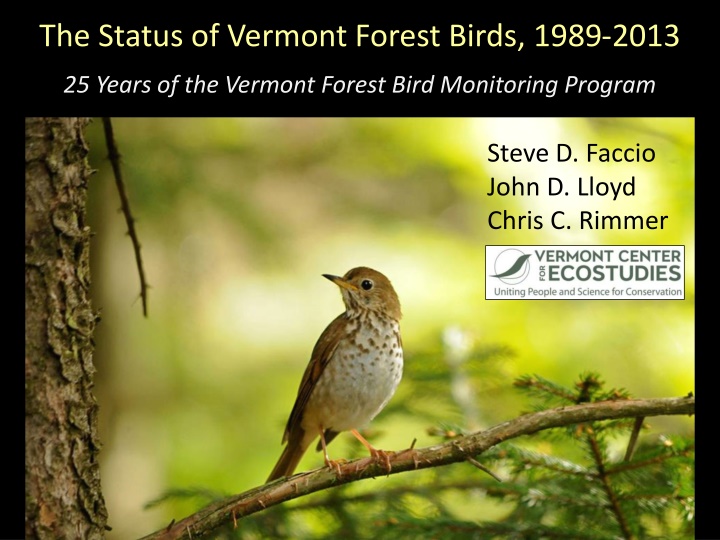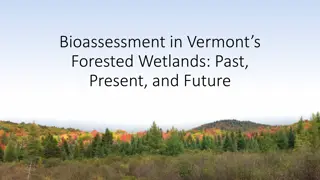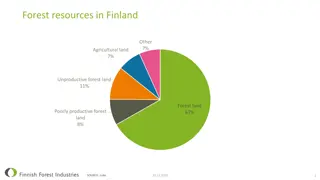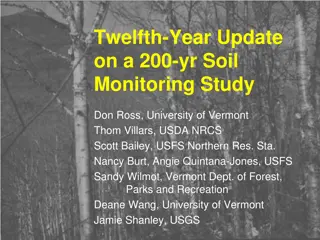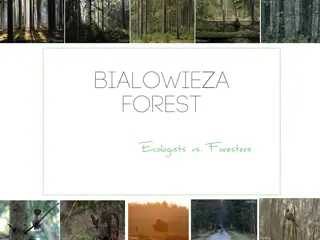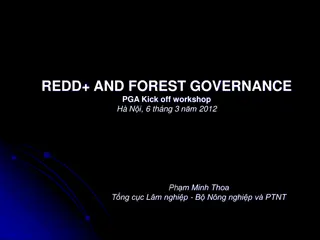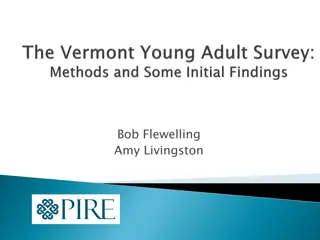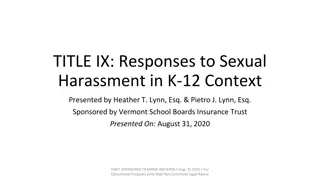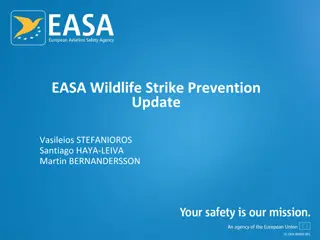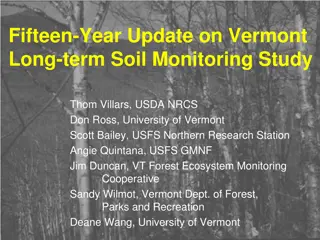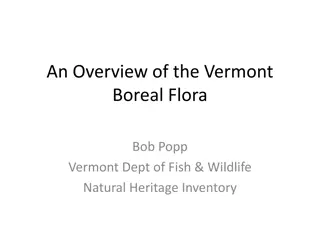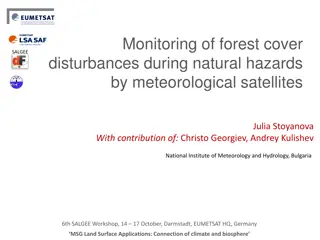Vermont Forest Bird Monitoring Program: 25-Year Trends
The Vermont Forest Bird Monitoring Program conducted 10-minute point counts at multiple study sites over 25 years. Results showed trends for 34 species and 13 guilds, with some species increasing significantly while others decreased. Notable findings include the positive trends of Red-eyed Vireo and Yellow-bellied Sapsucker. These birds play crucial roles in various habitats and are of regional conservation concern.
Download Presentation

Please find below an Image/Link to download the presentation.
The content on the website is provided AS IS for your information and personal use only. It may not be sold, licensed, or shared on other websites without obtaining consent from the author.If you encounter any issues during the download, it is possible that the publisher has removed the file from their server.
You are allowed to download the files provided on this website for personal or commercial use, subject to the condition that they are used lawfully. All files are the property of their respective owners.
The content on the website is provided AS IS for your information and personal use only. It may not be sold, licensed, or shared on other websites without obtaining consent from the author.
E N D
Presentation Transcript
The Status of Vermont Forest Birds, 1989-2013 25 Years of the Vermont Forest Bird Monitoring Program Steve D. Faccio John D. Lloyd Chris C. Rimmer
Ecosystem Services Pollination Pest Control Seed Dispersal Nutrient Cycling Whelan et al. 2015. Why birds matter: from economic ornithology to ecosystem services. J. Ornithol.
Vermont Forest Bird Monitoring Program Study Area & Field Methods Initiated in 1989 11 study sites 2012 31 study sites Interior forest, unmanaged stands Site = 5 survey points, ~200 m apart 10-minute point counts conducted annually by skilled birders
Analytical Methods 25-year Population Trend Estimates Developed mixed-effect models in program R -Response Variable = Count -Fixed Effect = Year -Observer and Site included as random effects. Species included in analysis if: Count >100 and number of Sites >5
Results Analyzed 2,464 point counts Detected 32,381 birds of 125 species Mean = 13.14 (+ 0.05 SE) birds/point
Modeled trends for 34 species and 13 guilds 8 species increased significantly 13 species decreased significantly 13 species non-significant 2 guilds increased significantly 7 guilds decreased significantly 4 guilds non-significant
The Good News Red-eyed Vireo Yellow-bellied Sapsucker Annual Change = 1.33% (SE 0.005) P = 0.015 Annual Trend = 3.82% (SE 0.005) P < 0.00000001 Annual Trend = 0.60% (SE 0.003) P = 0.049 Black-throated Green Warbler Ovenbird Annual Trend = 1.90% (SE 0.004) P = 0.00001 Annual Trend = 1.86% (SE 0.003) P < 0.000001
Among the most-abundant, widely-distributed, and easily-detected species on our surveys Occupy different habitats and ecological niches Red-eyed Vireo interior forest; canopy forager Yellow-bellied Sapsucker second growth/forest edge; bark prober Black-throated Green Warbler mature mixed forest; canopy forager Ovenbird mature deciduous forest; ground forager Listed as species of Regional Conservation Concern by Partners in Flight (PIF)
The Bad News Aerial Insectivores Great Crested Flycatcher Alder Flycatcher Chimney Swift Eastern Kingbird Eastern Phoebe Eastern Wood-Pewee Great Crested Flycatcher Least Flycatcher Olive-sided Flycatcher Tree Swallow Willow Flycatcher Yellow-bellied Flycatcher Eastern Wood-Pewee Annual Trend = -4.50% (SE 0.007) Annual Trend = -1.76% (SE 0.005) P < 0.000000 P = 0.0001 PIF Regional Concern Blue Jay Downy Woodpecker Annual Trend = -1.97% (SE 0.005) Annual Trend = -3.35% (SE 0.008) P = 0.0002 P = 0.00002 Annual Trend = -2.46% (SE 0.003) P < 0.000000
Veery White-throated Sparrow Annual Trend = -2.14% (SE 0.005) Annual Trend = -3.99% (SE 0.007) P = 0.000005 P < 0.000000 PIF Regional Concern Common Yellowthroat Canada Warbler PIF Regional Concern PIF Regional Concern VT High Priority SGCN Annual Trend = -6.30% (SE 0.007) P < 0.000000 Annual Trend = -5.10% (SE 0.009) P < 0.000000
Blackburnian Warbler Winter Wren PIF Regional Concern PIF Regional Concern Annual Trend = -1.73% (SE 0.007) P = 0.014 Annual Trend = -1.82% (SE 0.005) P = 0.0003 Yellow-rumped Warbler 5 of 7 nest and feed on or near the ground. Annual Trend = -4.49% (SE 0.007) P < 0.000000
Summary 24% (n=8) of species increased 63% (n=5) are PIF Priority 50% (n=4) are Neotropical migrants 38% (n=13) species declined 46% (n=6) are PIF Priority 62% (n=8) are Neotropical migrants
Summary West Nile Virus may be affecting some species High proportion of forested-wetland birds declining, 70% ground- or shrub-nesters/feeders Change in understory structure? High-risk habitat for WNV?
Funding for 25-year Analysis Davis Conservation Foundation Lintilhac Foundation William P. Wharton Trust Private Donors
Many Thanks to Our Birders! Carl Anderson Jayson Benoit Ken Benton Tom Berriman Bobbie Booth Ernie Buford Bridget Butler Bill Calfee Dwight Cargill Sarah Carline Brendan Collins Ken Cox Jason Crooks Chip Darmstadt Walter Ellison Brett Engstrom Steve Faccio Ted Gaine Hector Galbraith Mary Gaudette Jim Graves Scott Hall Eric Hanson Robert Heiser Tait Johansson Barry King Warren King Mark LaBarr Liz Lackey Sally Laughlin Sean MacFaden Everett Marshall Nancy Martin Tom Moran Doug Morin Scott Morrical Gregg Moxhay Terry Oughton Ron Payne Judy Peterson Bryan Pfeiffer Roy Pilcher Alan Quackenbush Charlie Rabatin Craig Reiser Rosalind Renfrew Heidi Rich Zoe Richards Chris Rimmer Betty Rist Sue Staats Ruth Stewart Matt Stone Ned Swanberg Michael Sweatman Allon Wildgust Paul Wilson Ian Worley Bob Wright
